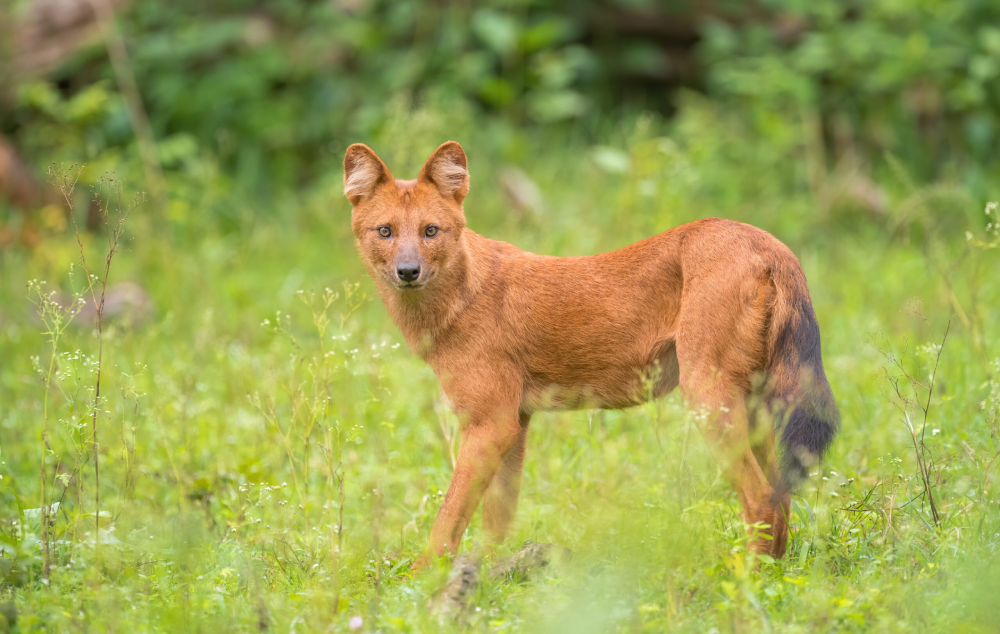The dhole, scientifically known as Cuon alpinus, is a remarkable and highly social canid native to various parts of Asia. Often referred to as the Asiatic wild dog, red dog, or Indian wild dog, the dhole is distinguished by its unique physical characteristics, complex social structures, and ecological importance. Despite its significant role in the ecosystems it inhabits, the dhole is a lesser-known species compared to other wild canids like wolves and foxes. This article delves into the dhole’s biology, behavior, habitat, conservation status, and the challenges it faces in the wild.
Physical Characteristics
The dhole is a medium-sized canid with a slender, muscular build. Adult dholes typically weigh between 12 to 20 kilograms and measure around 90 centimeters in body length. They are with a bushy tail adding another 40 to 45 centimeters (16 to 18 inches). Their coat color varies from reddish-brown to ochre, with lighter underparts. The fur is dense and soft, providing insulation against varying temperatures across its range. One of the most distinctive features of the dhole is its large, rounded ears, which aid in keen hearing.

Social Structure and Behavior
Dholes are highly social animals that live in structured packs typically comprising 5 to 12 individuals, although larger packs of up to 30 have been recorded. The social hierarchy within a pack is less rigid compared to that of wolves, with a more cooperative and egalitarian structure. Pack members work together in hunting, rearing young, and defending territory. Communication among dholes is complex, involving a variety of vocalizations such as whistles, clucks, and high-pitched screams. These sounds serve to coordinate pack activities, especially during hunts. Unlike wolves, dholes do not howl but rely on these unique sounds to maintain contact with pack members over long distances in dense forests.
Habitat and Distribution
Historically, dholes ranged across a vast territory stretching from Siberia to Southeast Asia. Today, their range has significantly contracted, and they are primarily found in fragmented populations in India, Nepal, Bhutan, Myanmar, Thailand, and parts of Indonesia and China. Dholes inhabit diverse environments, including tropical and subtropical forests, grasslands, and mountainous regions up to 5,000 meters (16,400 feet) in elevation.
Diet and Hunting Strategies
Dholes are carnivorous and exhibit remarkable hunting skills. They primarily prey on medium to large-sized ungulates such as deer, wild boar, and bovids. In some regions, they also hunt smaller animals, including hares and birds. Dholes are known for their endurance and cooperative hunting techniques. Packs work together to chase and exhaust their prey over long distances. Once the prey is caught, the pack members share the kill. That way they are ensuring that even the young and weaker members get their share.
Reproduction and Lifespan
The breeding season for dholes varies depending on their geographic location, but it generally occurs between October and January. Female dholes give birth to litters of 4 to 8 pups after a gestation period of about 60 to 63 days. Unlike many other canids, dhole pups are reared communally, with all pack members participating in their care and feeding. This cooperative breeding system helps ensure a higher survival rate for the pups. Dholes reach sexual maturity at around one year of age, but they typically do not breed until they are two or three years old. In the wild, dholes have a lifespan of about 10 to 12 years, although they can live longer in captivity.
Conservation Status and Threats
The dhole is classified as Endangered on the International Union for Conservation of Nature (IUCN) Red List. The global population of dholes is estimated to be fewer than 2,500 mature individuals, and their numbers are declining. Several factors contribute to this decline, including habitat loss, prey depletion, human-wildlife conflict, and disease. Rapid deforestation and habitat fragmentation due to agricultural expansion, logging, and urban development have significantly reduced the available habitat for dholes.
Overhunting and poaching of prey species such as deer and wild boar have led to food shortages for dholes, impacting their survival and reproductive success. Dholes are often persecuted by farmers and livestock owners who view them as a threat to their animals. Poisoning and retaliatory killings are common in some areas. Dholes are susceptible to diseases such as rabies and canine distemper, which can spread from domestic dogs. These diseases can decimate dhole populations, especially in fragmented habitats where genetic diversity is low.
Conservation Efforts
Efforts to conserve dholes involve habitat protection, anti-poaching measures, and community engagement. Some key initiatives include establishing and effectively managing protected areas such as national parks and wildlife sanctuaries to provide safe havens for dholes and their prey. Conducting research on dhole ecology, behavior, and population dynamics helps in understanding their needs and developing effective conservation strategies.
Monitoring populations through camera traps and field surveys is crucial for assessing conservation outcomes. Engaging local communities in conservation efforts is vital. Educating people about the ecological role of dholes and involving them in habitat restoration projects can reduce human-wildlife conflict and promote coexistence. Vaccination programs for domestic dogs in areas surrounding dhole habitats can help prevent the spread of diseases to wild populations.
Conclusion
The dhole, with its unique social behavior and ecological significance, is an important yet vulnerable species. Its presence indicates the health of the ecosystems it inhabits. Protecting dholes requires concerted efforts from governments, conservation organizations, researchers, and local communities. By addressing the threats they face and implementing effective conservation strategies, we can hope to secure a future for this remarkable canid and the biodiversity it helps sustain.









